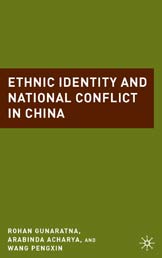A Review of: “Rohan Gunaratna, Arabinda Acharya, and Wang Pengxin. Ethnic Identity and National Conflict in China.”
New York: Palgrave Macmillan, 2010. 258 pp., $85.00 hardcover. ISBN: 978-0-230-10305-4.
Author: Raffaello Pantuccia
Affiliation: a International Center for the Study of Radicalisation (ICSR), London, UK
DOI: 10.1080/09546553.2011.555674
Article Requests: Order Reprints : Request Permissions
Published in: Terrorism and Political Violence, Volume 23, Issue 2 April 2011 , pages 320 - 321
Publication Frequency: 4 issues per year
To cite this Article: Pantucci, Raffaello 'A Review of: “Rohan Gunaratna, Arabinda Acharya, and Wang Pengxin. Ethnic Identity and National Conflict in China.”', Terrorism and Political Violence, 23:2, 320 - 321
The question of terrorism in China is one that, while fascinating, is surprisingly under-represented in academic literature. For foreigners, it can be a very hard subject to penetrate due to local sensitivities, and these same sensitivities plague local scholars who recount stories of colleagues whose criticism of current policy went too far and found themselves suddenly unable to work. Consequently, Rohan Gunaratna, Arabinda Acharya, and Wang Pengxin's work on the subject is warmly welcomed in helping to cast some light on the subject.
Focusing primarily on Islamist “extremism and terrorism” in China (p. 1), and the product of research done at the behest of “a number of Chinese institutions” seeking “an assessment of the threat” ahead of the 2008 Olympic games (p. 6), this book offers an overview of the current state of Islamist terrorist groups and networks in China. Given the prevalence of Islam and Islamist networks in China's westernmost Xinjiang province, the focus of the book is primarily Uighur religio-ethnic-separatist groups that claim linkages to this region. Given the authors' publishing record on the topic of Al Qaeda in Afghanistan and Pakistan and the organization's affiliates, this is not a surprising prism with which to explore the problem.
The book is quite traditional in its academic approach, opening with a chapter on placing the problem in China in a proper and current theoretical framework (pp. 9-19). It then provides an overview of Islam's arrival and growth in China (pp. 20-46), before launching into its longest chapter, which focuses in telegraphic detail on the multiplicity of Turkestan-related groups and networks preoccupying the Chinese government (pp. 47-88). Later chapters focus on “Threats to China from Al Qaeda” (pp. 109-134) and finally, what China is doing to respond (pp. 135-170). It is, however, chapter 4 (pp. 89-107) that raises a few questions, focusing as it does on the potential for radicalisation amongst China's Hui Muslim minority.
This conclusion is reached on the basis that there has been an increase since the late 1990s in the number of madrassahs (religious schools) “with radical orientation” (p. 104). Further evidence is suggested in the increasing numbers of Hui Muslims speaking Arabic, and the large numbers going on Hajj. Alongside this increasing exposure to the broader Muslim ummah, the authors track the increase in radical ideologies and movements globally and reach the conclusion that “under the influence of radical Islam and the global jihadist movement the Hui might become increasingly 'unfamiliar strangers'” (p. 106). However, this seems a slightly extreme conclusion to reach, given the current lack of violent radical behaviour stemming from Hui communities in China at the moment.
This aside, the book is a very useful stock-take of the current state of events attributed to the various East Turkestan groups. The middle chapters have clearly been researched using a wide array of Chinese source material and they provide a comprehensive assessment of events that have been somewhat muddled in the press. There is also an overview of all the different Uighur dissident groups based abroad that the Chinese government is concerned about—though it is unclear how many interviews have been conducted with members of said groups and the information varies in depth.
Controversially, the authors here conclude that “resentment caused by Han Chinese culture and language is not widespread” and “repression [of religious practices] is not evident in Xinjiang” (p. 60)—a perspective that is unlikely to endear them to the community of experts watching this topic from an ethnic perspective. This is already suggested in an article written by eminent expert Jim Milward in the Central Asian Survey special edition on Xinjiang, in which he expresses some concern about Dr. Gunaratna's approach to the issue of terrorism in China.1
This clash is unfortunate, as terrorism in China, be it from international networks or domestic dissidents, is clearly going to rise as the nation's profile and importance in the global economy increases.2 This is something that is going to be of increasing concern to the international community. Unfortunately, information is often rather limited on the subject and province, so the baseline assessment this book provides does help start to complete a gap in current literature.
Notes
James Millward, “Introduction: Does the 2009 Urumchi violence mark a turning point?,” Central Asian Survey 28, no. 4 (2010): 347-360.
Paul J. Smith, “China's Economic and Political Rise: Implications for Global Terrorism and U.S.-China Cooperation,” Studies in Conflict and Terrorism 32, no. 7 (2009): 627-645.

No comments:
Post a Comment